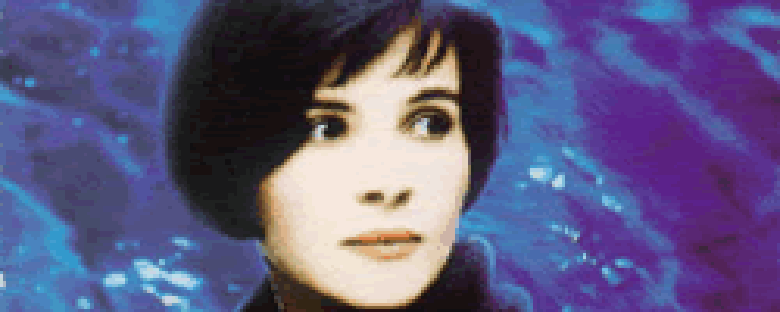Reviews
Trois couleurs: Bleu
Krzysztof Kieslowski
France / Poland, 1993
Credits
Review by Rumsey Taylor
Posted on 11 July 2004
Source VHS
Midway through Blue, Julie, a recently made widow, visits her mother in a rest home. The older woman is distant (she does not recognize her daughter). On a television in front of them are images of older people bungee jumping against a soft blue sky. Julie becomes distracted by the television momentarily, as if she is briefly interested in the odd sport.
The image of the bungee jumpers can be aligned with Julie’s case. Both are seeking escape; dissimilarly, however, for Julie there is no immediate catharsis upon losing both her husband and daughter in a car crash.
In the days following her loss Julie exercises an ability to remain numb to any human feeling. She sleeps with her husband’s assistant (who has secretly loved her, it is revealed), in a disinterested seduction, in an effort to feel. The next morning she suddenly leaves, chafing her clenched fist against a stone wall as she retreats. Neither action results in any identifiable emotion in her face.
Julie’s chief aim is to rid herself of the memory of her family, including her house and money. She moves to an apartment in Paris and adopts her maiden name. “What will you do?” asks her lawyer. “Nothing” she replies bluntly. Anonymity will be her freedom.
Upon her relocation Julie retreats frequently to a pool (often she is alone, immersed in an expanse of blue). On one visit she exits the pool and a swarm of children jump in. Each is wearing a white skullcap and bathing suit and red floaties. This action is filmed in shallow focus, and it appears as streams of the colors white and red flowing past her in a current. The symbolism in this scene seems intended. Its meaning, if any, is infinitely debatable.
The closing sequence of Blue is a thing of complex ambiguity. A concerto penned by Julie’s late husband commands the sequence with sharp chords, and a patient camera pans across the film’s players. The sequence ends with the final image in the film, of Julie, whose face shows evidence of tears for the first time. This scene is a masterstroke, and appropriately ends the film without achieving closure.
Kieslowski is a master of subtlety and symbolic allusions, (primarily, color symbolism is in obvious abundance). The underlying trait of his trilogy is that people may come in contact with others only briefly, yet even the most minor interaction may carry a tremendous and unknown influence. The end of Blue evidences this, and correspondences between the remaining films in the trilogy further the notion.
Blue in the French flag denotes liberty, and it is with hesitation that I cite this detail for it forces certain interpretations of the film. Blue is justifiably the story of Julie’s liberation, though other emotive themes are at play. The French flag contains three colors, each attributed to an idiomatic and political usage. These three terms (in whole; not succession) are in use during the entire trilogy.
Blue is a gorgeous, dramatic and tragic film. It is worthy of being measured by its own singular worth. However, only when viewed as the opening of Kieslowski’s “Three Colors” does it garner further meaning …
We don’t do comments anymore, but you may contact us here or find us on Twitter or Facebook.



